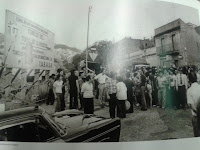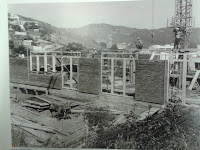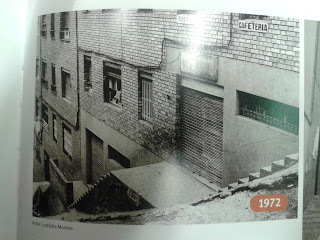 The inhabitants of El Carmel were ones of the most sentimentally
attached to their neighbourhood and therefore struggled with intensity
towards better living conditions. The solidarity between the people and
the constant claims led to a general improvement, socially and
politically towards the population.
The inhabitants of El Carmel were ones of the most sentimentally
attached to their neighbourhood and therefore struggled with intensity
towards better living conditions. The solidarity between the people and
the constant claims led to a general improvement, socially and
politically towards the population.
° 1968 : The Social center of el Carmel is created by a group of barraquista
It has worked tirelessly to rescue the neighbourhood of institutional neglection and improve the living conditions
With the civil war,
el Carmel again stayed with no transport and the bus line was suppressed that left the neighbourhood during 25
years with no communication.
Nowadays there are several buses and metro than lead you there. In July 2010 was inaugurated the subway extension with the commissioning of two new stations, El Carmel and The Coll / The Teixonera.
Nowadays there are several buses and metro than lead you there. In July 2010 was inaugurated the subway extension with the commissioning of two new stations, El Carmel and The Coll / The Teixonera.
Self Constructions and strong solidarity
Social claims and first bricks


 During the re-accomodation, the
actions of the associacion de Veïns del Carmel started the process
of eradication del barraquismo. After 50 years of privation and 20
years of struggle, people finally receive a more decent housing. The
Polygon Canyelles was part of the new resettlement, and in 1977, only
123 families accepted to change house. People were claiming better
conditions but some of them did not wish to be living somewhere else than on their
land.
During the re-accomodation, the
actions of the associacion de Veïns del Carmel started the process
of eradication del barraquismo. After 50 years of privation and 20
years of struggle, people finally receive a more decent housing. The
Polygon Canyelles was part of the new resettlement, and in 1977, only
123 families accepted to change house. People were claiming better
conditions but some of them did not wish to be living somewhere else than on their
land.
Urbanization development of the neighbourhood
Here is an example of the urbanization process in the barrio, where we can see the instalations of mecanical stairs. In the 90's the city hall has addressed the structural deficits, pipelines, utilities, lighting, asphalted, transport and land accessibility difficulties with the installation of numerous elevators and escalators. Among the work carried out included the opening of the Rambla del Carmel, one of the main roads of the district. and the widening of the street Llobregós-which involved the expropriation of another 500 families and the disappearance of the only local cinema. 








Cap comentari:
Publica un comentari a l'entrada